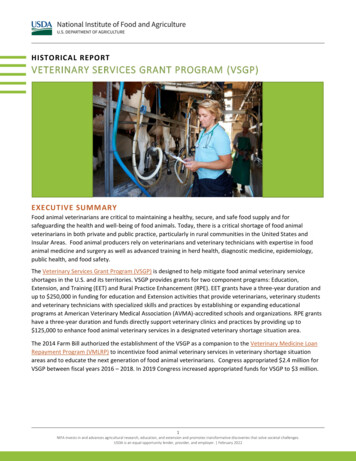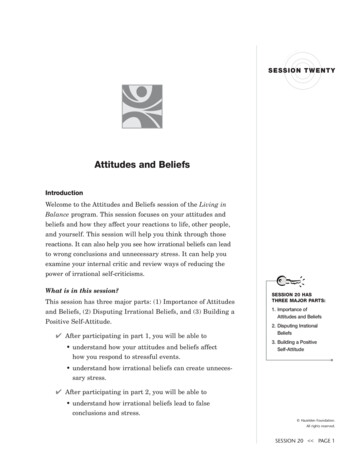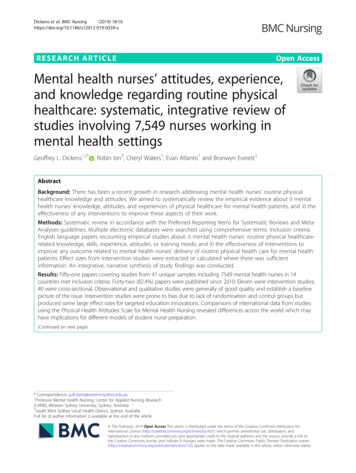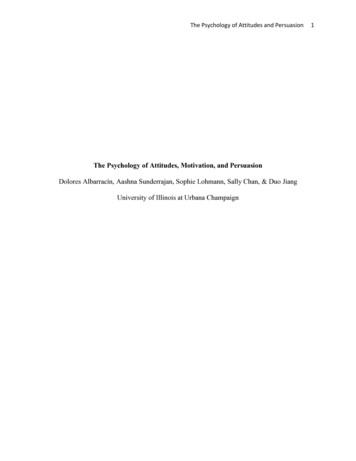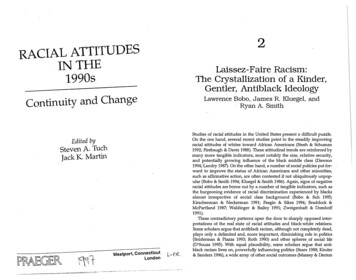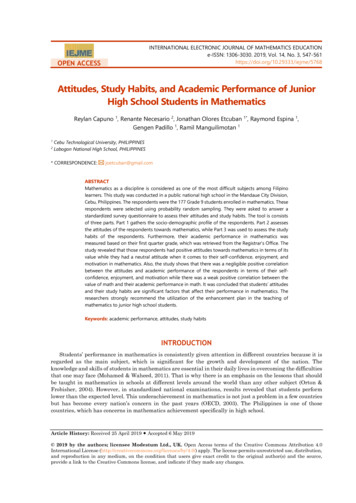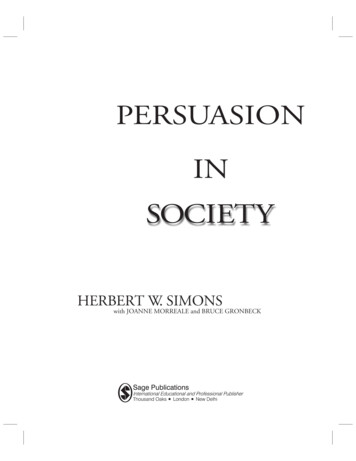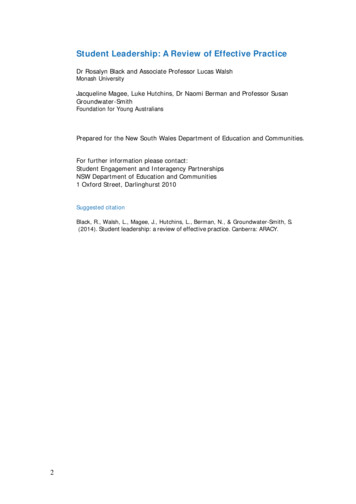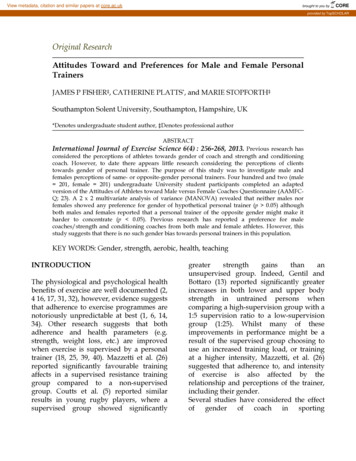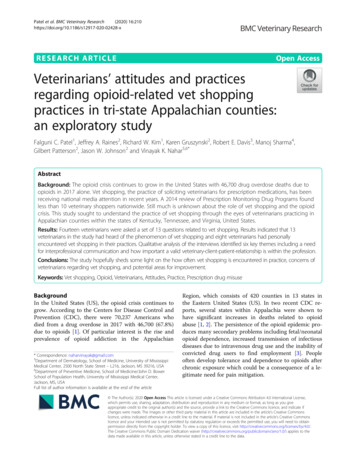
Transcription
Patel et al. BMC Veterinary Research(2020) SEARCH ARTICLEOpen AccessVeterinarians’ attitudes and practicesregarding opioid-related vet shoppingpractices in tri-state Appalachian counties:an exploratory studyFalguni C. Patel1, Jeffrey A. Raines2, Richard W. Kim1, Karen Gruszynski2, Robert E. Davis3, Manoj Sharma4,Gilbert Patterson2, Jason W. Johnson2 and Vinayak K. Nahar5,6*AbstractBackground: The opioid crisis continues to grow in the United States with 46,700 drug overdose deaths due toopioids in 2017 alone. Vet shopping, the practice of soliciting veterinarians for prescription medications, has beenreceiving national media attention in recent years. A 2014 review of Prescription Monitoring Drug Programs foundless than 10 veterinary shoppers nationwide. Still much is unknown about the role of vet shopping and the opioidcrisis. This study sought to understand the practice of vet shopping through the eyes of veterinarians practicing inAppalachian counties within the states of Kentucky, Tennessee, and Virginia, United States.Results: Fourteen veterinarians were asked a set of 13 questions related to vet shopping. Results indicated that 13veterinarians in the study had heard of the phenomenon of vet shopping and eight veterinarians had personallyencountered vet shopping in their practices. Qualitative analysis of the interviews identified six key themes including a needfor interprofessional communication and how important a valid veterinary-client-patient-relationship is within the profession.Conclusions: The study hopefully sheds some light on the how often vet shopping is encountered in practice, concerns ofveterinarians regarding vet shopping, and potential areas for improvement.Keywords: Vet shopping, Opioid, Veterinarians, Attitudes, Practice, Prescription drug misuseBackgroundIn the United States (US), the opioid crisis continues togrow. According to the Centers for Disease Control andPrevention (CDC), there were 70,237 Americans whodied from a drug overdose in 2017 with 46,700 (67.8%)due to opioids [1]. Of particular interest is the rise andprevalence of opioid addiction in the Appalachian* Correspondence: naharvinayak@gmail.com5Department of Dermatology, School of Medicine, University of MississippiMedical Center, 2500 North State Street – L216, Jackson, MS 39216, USA6Department of Preventive Medicine, School of Medicine/John D. BowerSchool of Population Health, University of Mississippi Medical Center,Jackson, MS, USAFull list of author information is available at the end of the articleRegion, which consists of 420 counties in 13 states inthe Eastern United States (US). In two recent CDC reports, several states within Appalachia were shown tohave significant increases in deaths related to opioidabuse [1, 2]. The persistence of the opioid epidemic produces many secondary problems including fetal/neonatalopioid dependence, increased transmission of infectiousdiseases due to intravenous drug use and the inability ofconvicted drug users to find employment [3]. Peopleoften develop tolerance and dependence to opioids afterchronic exposure which could be a consequence of a legitimate need for pain mitigation. The Author(s). 2020 Open Access This article is licensed under a Creative Commons Attribution 4.0 International License,which permits use, sharing, adaptation, distribution and reproduction in any medium or format, as long as you giveappropriate credit to the original author(s) and the source, provide a link to the Creative Commons licence, and indicate ifchanges were made. The images or other third party material in this article are included in the article's Creative Commonslicence, unless indicated otherwise in a credit line to the material. If material is not included in the article's Creative Commonslicence and your intended use is not permitted by statutory regulation or exceeds the permitted use, you will need to obtainpermission directly from the copyright holder. To view a copy of this licence, visit http://creativecommons.org/licenses/by/4.0/.The Creative Commons Public Domain Dedication waiver ) applies to thedata made available in this article, unless otherwise stated in a credit line to the data.
Patel et al. BMC Veterinary Research(2020) 16:210With ever changing laws and new criteria for prescribing opioid pain medications, drug seekers have becomemore creative in their efforts to obtain opioids. One ofthe newest avenues for drug seeking behavior is veterinary clinics [4]. “Vet shopping” is the solicitation of veterinarians to obtain a controlled substance prescription fortheir animal with no intent of administering to their animal [5]. Recent media reports have thrusted vet shopping into the spotlight. Within the last several years, araid of dog breeding operation in Oregon found approximately 100,000 Tramadol pills in the owners’ possession,a Kentucky woman who was arrested for intentionallycutting her dog in order to obtain Tramadol, and a manin Fairfax County, Virginia who was visiting multipleveterinary clinics to obtain prescription medications forhis pet [6–9]. It is still unclear what impact vet shoppingactually has on the opioid epidemic.In 2014, a fifty state survey of Prescription Drug Monitoring Programs (PDMP) found that there were less thanten veterinary shoppers identified nationwide by thevarious state programs [10]. While the number might besmall, it should be noted that not all states require veterinarians to participate in PDMP thus it could be underreported [11]. The American Veterinary MedicalAssociation (AVMA) also advocates the need for optionsfor reporting of suspected opioid and controlled substance drug shoppers and/or diversion which could alsoimpact the number of vet shoppers reported [12].Recognizing the spread and persistence of the currentopioid epidemic in Appalachia and the need for more information regarding vet shopping behavior, this studysought out to assess the attitudes, knowledge base andmanagement practices among a cohort of veterinariansin South – South Central Appalachian states regardingvet shopping behavior. The data gathered from thisstudy will provide a better understanding regarding theattitudes and practices used by veterinarians related tovet shopping and will provide insight for future researchand intervention strategies regarding vet shopping.ResultsFourteen veterinarians from 14 different practices located within the Appalachian footprint of Kentucky,Tennessee, and Virginia participated in this qualitativestudy. Among the veterinarians interviewed, eight practiced in Tennessee, four in Kentucky, and two in Virginia. Table 1 displays practice characteristics ofrespondents (Questions 1–6, 10, and 12). Of the 14 veterinarians, 8 (57.1%) reported practicing medicine over20, years. Thirteen veterinarians (92.9%) have heard ofthe practice of vet shopping. Eight veterinarians (57.1%)reported seeing 100 or above patients per week. The majority of veterinarians (9 [64.3%]) practiced in a cliniccatering exclusively to small animals. Eight of 14 (57.1%)Page 2 of 8veterinarians reported personally encountering vet shopping in their own practice. Two veterinarians (14.3%) indicated vet shopping was not a problem. Four veterinarians(28.6%) reported receiving training on prevention and/ormanagement of vet shopping. One veterinarian (7.1%) wasfound to be unaware of the phenomenon of vet shopping.Table 2 displays thematic analysis of qualitative data(Questions 7–9, 11, and 13) which highlights the six themesidentified: interprofessional communication, knowing clients and patients, education, information sharing/database,judicious use of opioids, optimistic/not concerned. Tracking of verbalized responses were cumulatively totaledthroughout all interviews. That is, an interviewee may havementioned a particular theme twice, in response to two different questions, which would have counted as two verbalizations towards the total.Interprofessional communicationVeterinarians interviewed in this study expressed a desire to communicate generally and more efficiently withother veterinary colleagues and medical professionals.The desire for the ability to communicate with pharmacies/pharmacists was verbalized six times throughout theinterviews, expressing this value when questioned regarding methods to prevent vet shopping, best practicesto prevent vet shopping, control/management of vetshopping, and resources needed to prevent vet shopping.The ability to communicate with other veterinary professionals was verbalized by five times during the course ofthe interviews with veterinarians conveying this valuewhen questioned regarding limitations in their ability toprevent vet shopping, control/management of vet shopping and resources needed to prevent the practice of vetshopping.Knowing clients and patientsA valid veterinary-client-patient-relationship (VCPR)was a value expressed by multiple veterinarians withinthis study. VCPR was cumulatively mentioned 50 timesthroughout the course of the interviews. Interviewed veterinarians verbalized verbatim a valid VCPR or the tenets thereof when asked about methods to help in theprevention of vet shopping, best practices to prevent vetshopping, limitations in their ability to prevent vet shopping, control/management of vet shopping, resourcesneeded to prevent vet shopping and how veterinarianscould address the opioid crisis.EducationVeterinarians expressed the desire for more education forthemselves and/or their staff members 11 times, verbalizinga desire for education when questioned regarding best practice for prevention of vet shopping, limitations in their
Patel et al. BMC Veterinary Research(2020) 16:210Page 3 of 8Table 1 Practice Characteristics of Respondents (n 14)Themes1. How many years have you been in practice?0–105 (35.6%)11–201 (7.1%)21–304 (28.6%)30–404 (28.6%)2. Have you ever heard of the practice of vet shopping?3. How many new and returning patients do you see,on average, during a typical work week?4. Please describe your practice structure (small animalpredominant, mixed practice, large animal predominant).5. Have you ever encountered Vet shopping?6. To what extent do you think Vet Shopping isa problem in our Tri-State region?Subthemesn (%)QuestionsYes13 (92.9%)No1 (7.1%)1–491 (7.1%)50–995 (35.6%)100–1495 (35.6%)150–1991 (7.1%)200 2 (14.3%)Small-animal predominant9 (64.3%)Large-animal predominant1 (7.1%)Mixed-animal practice4 (28.6%)Yes8 (57.1%)No6 (42.9%)Not a problemIt is a problem2 (14.3%)Minor problem4 (28.6%)Somewhat of a problem7 (50%)A big problem1 (7.1%)10. Have you received any training on prevention and/ormanagement of Vet Shopping?Yes4 (28.6%)No10 (71.4%)12. Is there information sharing between human doctors,veterinarians, and other entities such as law enforcement aboutcurrent drug seeking behaviors or warnings about peopleseeking drugs (e.g. Break-ins at clinics)?Yes7 (50%)No6 (42.9%)Uncertain1 (7.1%)ability to prevent vet shopping, control/management of vetshopping and resources needed to prevent vet shopping.Information sharing/databaseVeterinarians expressed a need or desire to be able totrack and control animal prescriptions through databaseslike the Kentucky All Schedule Prescription ElectronicReporting (KASPER). It was verbalized seven times whenquestioned regarding prevention and control of vetshopping and resources needed.Judicious use of opioidsVeterinarians emphasized the judicious use of opioid prescriptions, verbalizing it 33 times throughout the interviews. The judicious use of opioids was mentioned whenasked about vet shopping prevention, control or management of vet shopping and addressing the opioid crisis.Optimistic/not concernedThree of 14 veterinarians expressed optimism or nonconcern regarding vet shopping.DiscussionThe findings of this study show that veterinarians practicing in the tri-state region expressed a need for moreefficient communication between themselves, other veterinary colleagues, medical professionals including pharmacists and law enforcement regarding the use ofprescription opioids by clients and their pets. Only twoout of the 14 veterinarians interviewed believed that vetshopping was not a concern for them. The remaining 12believed it to be a problem that needed to be addressed.One potential solution to improve communication andgain information concerning prescription opioid use byclients and their pets is through a prescription drugmonitoring program.While laws are currently in place across the nation tocurb human physician shopping, only 20 states and District of Columbia have addressed the vet shopping issueby requiring veterinarians to report dispensing of controlled substances into Prescription Drug MonitoringPrograms (PDMPs) [11]. PDMP programs have historically proven successful in limiting human physician
Patel et al. BMC Veterinary Research(2020) 16:210Page 4 of 8Table 2 Thematic Analysis of Qualitative Data (n 14)QuestionsThemes7. What is your opinion about VetShopping?Optimistic/Notconcerned8. How can veterinarians help inprevention of Vet Shopping?InterprofessionalCommunicationa. Probe: In your opinion, what wouldbe the best practice to prevent VetShopping?b. What factors might limit your abilityto prevent vet shopping?Subthemes11. What resources do you need toprevent Vet shopping?n (%)2 (14.3%)2 (14.3%)Communicate withPharmacies/Pharmacists“I think being in closer contact sometimers with thepharmacist. They have been extremely helpful ”1 (7.1%)Communicate withlaw enforcement“I mean you can report those people to animalcontrol officers or even the sheriff’s department orlaw enforcement ”1 (7.1%)Knowing Clientsand Patients“I think what you have to do is to know yourclientele ”10 (71.4%)Informationsharing/database“The biggest thing would be if we had some sort ofdatabase ”2 (14.3%)Judicious Use ofOpioids“Don’t just overprescribe pain medications ”10 (71.4%)InterprofessionalCommunication2 (14.3%)Communicate withPharmacies/Pharmacists“Well one thing you can do is call most of the drugs 2 (14.3%)into the pharmacy ”Knowing Clientsand Patients“Probably just adhere to that animal client veterinary 8 (57.1%)relationship before anything would be ly, some sort of database ”1 (7.1%)Judicious Use ofOpioids“.I think just being careful and not routinelydispensing too much ”6 (42.6))InterprofessionalCommunication2 (14.3%)“I guess some of that is we’re not sure if they havebeen to other people, to other veterinarians ornot ”2 (14.3%)Knowing Clientsand Patients“I guess people lying ”11 (78.6%)Education“Definitely the education of the veterinarians coming 2 (14.3%)out that it is you know a problem ”Communicate withOther VeterinaryProfessionals9. How can veterinarians help in controlor management of vet shopping?Supporting Quotes“I have not had many incidences of it”Interprofessionalcommunication4 (28.6%)Communicate withPharmacies/Pharmacists“To work more closely with the pharmacist ”2 (14.3%)Communicate withOther VeterinaryProfessionals“Well communicating with other practices in thearea ”2 (14.3%)Knowing Clientsand Patients“I guess it goes back to knowing the patient andknowing what the patient actually needs.”8 (57.1%)Education“Being more aware of what’s going on ”2 (14.3%)InformationSharing/Database“Maybe even there should be some kind ofdatabase ”3 (21.4%)Judicious Use ofOpioids“Honestly I think we could be a little less inclined toreach for pain meds on every occasion”6 (42.9%)Interprofessionalcommunication3 (21.4%)
Patel et al. BMC Veterinary Research(2020) 16:210Page 5 of 8Table 2 Thematic Analysis of Qualitative Data (n 14) (Continued)QuestionsSubthemesSupporting Quotesn (%)Communicate withPharmacies/Pharmacists“I do think you know a close relationship withpharmacies ”1 (7.1%)Communicate withOther VeterinaryProfessionals“More of a freedom within the community, themedical community, and the veterinary communityto discuss the topics ”1 (7.1%)Communicate withLaw Enforcement“I think you have to have a relationship with lawenforcement ”1 (7.1%)Knowing Clientsand Patients“.a good relationship with your client.”7 (50.0%)Education“A CE (continuing education) course that would ”7 (50.0%)InformationSharing/Database“I think maybe the CASPR reports where we can seeif an individual has a history of using a particularmedication.”1 (7.1%)Optimistic/NotConcerned“I think we have the resources we need ”1 (7.1%)“Just know your clients, know their needs, and besure you have a doctor-client-patient relationship”6 (42.9%)“And to be sparing in your prescriptions as far as inthe amount and number of days ”11 (78.6%)Themes13. What are some things that you think Knowing Clientsveterinarians can do to help address the and Patientsopioid crisis?Judicious Use ofOpioidsshopping. For example, the CDC reports that in 2012,after a law requiring human medical prescribers to checkthe state’s PDMP before prescribing opioids was put intoplace, there was a 75% drop in doctor shopping the following year [13].Veterinarians may be opposed to the restrictionsplaced on them by new legislation, just as many humanmedical doctors likely pushed back against an additionto their already busy workflow when PDMP programswere implemented in human medicine. But because it isa possible avenue for addicts and drug dealers to obtainopioids, it must be addressed. This study showed veterinary professionals express a desire to be able to trackanimal prescriptions through databases and learn moreand take action regarding this epidemic. ThroughPDMPs and education, veterinarians can be more vigilant of this issue and prevent owners from dishonestlyobtaining prescriptions.One of the greatest tools to aid in the accurate identification of a drug seeking client is a relationship with theclient and patient. Simply stated, veterinarians are ableto identify patients who seek drugs, if they know them.There is no magical way to form relationships with clients who are first timers, and although relationships arebuilt over time, there are certain red flags to watch outfor when treating patients.Signs of an owner seeing a veterinarian simply for controlled substances may be subtle but recognizable if aveterinarian watches for them. Red flags include: newpatients bringing in seriously injured animals, ownersdescribing symptoms that are inconsistent with the examor which require specific medications, requests for medications by name, requesting refills, or aggressive behavior [8]. Other warning signs include: pets with chronicinjuries, new injuries, and injuries with unknown causes[14]. While this paper provides actionable information,more research should be done to better understand thechallenges veterinarians face when confronted with theaforementioned red flag scenarios and more explicitguidelines should be sought to aid clinicians in thesechallenging, and potentially more frequent, situations.As a recurring theme throughout the interviews wasthe desire for more veterinarian education on thistopic, the aforementioned information regarding ‘redflags’ and other related knowledge must be better disseminated among the profession in order to quellillicit opioid access. One method used to addresspublic health concerns is by educating practitionersthrough continuing education programs. Multiplestates in the US have begun to require pain management/controlled substance prescribing continuingeducation (CE) requirements for human physicians[15]. Opioid and other controlled substance prescribing CE programs may be an effective avenue to improve veterinarian education regarding vet shopping.As this study found, judicious use of opioids was aprimary concern among veterinarians and potentialpoint of improvement in addressing vet shopping andthe opioid crisis as a whole. Continuing educationprograms could encourage the judicious use of opioids by veterinarians and prove an actionable and effective step towards addressing this issue.
Patel et al. BMC Veterinary Research(2020) 16:210Page 6 of 8However, there are several limitations in this study. Onepotential limitation is a bias of convenience in that theveterinarians were recruited using an online search engine.Thus, veterinarians who did not have an online presencewere excluded from the study. Recruitment of participantswas also subject to geographical bias, as veterinarians involved in practicing only in the Central – South CentralAppalachian states of Tennessee, Virginia, and Kentuckywere included in this study. Furthermore, the method ofdata collection was through telephone interviews whichdoes not allow for participant observation. Future studiescan incorporate face-to-face interviews. While this was aqualitative study, the sample size could certainly havebeen more diverse. Due to the anonymous nature of thesurvey it was a challenge to include certain descriptivedata. Future studies could include more descriptive data,such as gender and specific geographical data of veterinarians interviewed in order to better characterize the respondents in the region studied. The sample sizeconsisted of 14 participants which limits the conclusionsdrawn from this study - future studies with a more robustsample would be of value.Taking data from the Association of American Veterinary Medical Colleges (AAVMC) and DATAUSA, we canestimate the mean number of years practiced for all veterinarians to be 17.3 [16, 17]. Our results show that themean number of years of surveyed participants practicingveterinary medicine was 21. Thus, the veterinarians surveyed may be older and have likely practiced longer thanthe average U.S. veterinarian. This age and practice experience discrepancy may have influenced perceptions of theopioid crisis. Most of the respondents were small animalclinicians; however, no studies to our knowledge associatevet shopping frequency and small animal practices. Regardless, this may impact generalization of this study’sfindings and further studies should be conducted to investigate if this phenomenon occurs more frequently in smallanimal practices.There were also some limitations regarding the dataanalysis. The psychometric properties of the instrument developed by the researchers, beyond face and content validation, were not established. Future studies may addressestablishing internal consistency reliability, test-retest reliability, and construct validation. Triangulation with elaborate quantitative methods was not done in this study. Futurestudies must utilize systematic mixed-methods designs toenhance the creditworthiness and trustworthiness of the results. Qualitative statistical software such as N-Vivo orAtlas were not used and manual thematic analysis wasdone, which can add to greater subjectivity.behavior, this study sought to assess the attitudes, knowledge base and management practices amongst a cohort ofveterinarians in South – South Central Appalachia regarding vet shopping. The overwhelming majority of veterinarians’ responses highlighted the importance of informationsharing/databases, interprofessional communication, continuing education and advocating the judicious use of opioids in addressing this insidious phenomenon. Theseresults suggest a need for a nationwide veterinarian accessible prescription drug monitoring program and theneed for more research to address gaps in current statePDMP reporting versus what is encountered in veterinarypractice, as many of the practices encountered vet shopping, but very few reports of vet shopping were found in anationwide search. The results of this study also indicatethat continuing education programs highlighting painmanagement/controlled substance prescribing, the judicious use of opioids, and red flag drug seeking behavior,amongst others, could be beneficial in quelling vet shopping. As a qualitative study with limited sample size, prudence must be taken with these generalizations and serveas an impetus for future study and justification for deeperinvestigation into the unfortunate practice of opioid solicitation via vet shopping.ConclusionsAppreciating the extent of the opioid epidemic in Appalachia and the gap in information regarding vet shoppingInstrumentMethodsParticipants and procedureA list of potential participants was generated using a directory of LMU College of Veterinary Medicine clinical affiliatessupplemented with an internet search of veterinarians in theAppalachian Region of Kentucky, Tennessee, and Virginia.The survey instrument (Additional file 1: Vet Shopping Survey) utilized was developed by researchers of this study. Potential participants were then contacted via phone call[Institutional Review Board (IRB); Protocol #:705 V.1]. Firstcontact was made to a receptionist at the clinic, who thengave us contact to the veterinarian. A script was read at thestart of the interview to relay the purpose of the interviewand to explain the research study. The script also explainedthat the interview would be audio recorded, and oral consentfor participation in the study was obtained. Interviews withveterinarians were conducted via speakerphone and recordedusing Olympus V414111 SU000 Digital Dm-720 Voice Recorder. No identifiable markers were collected during theinterview process and confidentiality/anonymity of subjectswas maintained. Thirteen questions were asked during theinterview plus a few probes. Any summaries of interviewswere sent to veterinarians via email upon request. The audiorecording was then transferred to another researcher fortranscription.At the start of the interview, the study was explainedfollowed by a 13-question interview with several probes
Patel et al. BMC Veterinary Research(2020) 16:210assessing veterinary attitudes and practices regarding vetshopping. Questions 1, 3, and 4 inquired about the veterinarian’s practice, including how many years they havebeen in practice, the number of patients seen per week,and their practice structure (small animal predominant,mixed practice, or large animal predominant). Questions2 and 5 assessed whether or not they had ever heard ofor encountered vet shopping. Questions 6 and 7 askedtheir opinion about vet shopping and the extent towhich vet shopping was a problem in the tri-state region. Questions 8 and 9 assessed how veterinarians canhelp in the prevention or control of vet shopping. Furthermore, probing questions for 8 and 9 assessed whatthe best practices and limiting factors were to prevent orcontrol vet shopping. Questions 10–12 asked if the veterinarian had received any training on prevention/management of vet shopping, any resources they need toprevent vet shopping, and whether there was any information sharing between human doctors, veterinariansand other entities such as law enforcement aboutcurrent drug seeking behaviors. Finally, question 13 inquired about possible things vets could do to help address the opioid crisis.Page 7 of 8AcknowledgmentsWe would like to thank all the veterinarians who participated in this researchstudy. This article was presented at Association of American VeterinaryMedical Colleges, Annual Meeting, Washington, DC, March, 2019.Authors’ contributionsVKN contributed to conception and design; VKN, KG, MS, and GP contributedto instrument development; FCP and JAR contributed to collection of data;FCP, JAR, VKN, KG, and RED contributed to analysis of data; FCP, JAR, RWK,KG, RED, MS, GP, JWJ, and VKN contributed to interpretation of data; FCP,JAR, RWK, KG, RED, MS, GP, JWJ, and VKN drafted the article or revised itcritically for important intellectual content; FCP, JAR, RWK, KG, RED, MS, GP,JWJ, and VKN gave final approval of the version of the article to bepublished; FCP, JAR, RWK, KG, RED, MS, GP, JWJ, and VKN agree to beaccountable for all aspects of the work in ensuring that questions related tothe accuracy or integrity of any part of the work are appropriatelyinvestigated and resolved; and all authors have read and approved themanuscript.FundingNo funding was obtained for this study.Availability of data and materialsThe datasets used and/or analyzed during the current study are availablefrom the corresponding author on reasonable request.Ethics approval and consent to participateData were collected via telephone interview; therefore, verbal consent wasobtained from the participants to participate in this study which is a feasiblemethod for such studies. All procedures including verbal method of consentto participate were approved via Institutional Review Board (IRB) at theLincoln Memorial University (Protocol #705 V.1).Data analysisAll audio recordings were fully transcribed. Responsesfrom the interview were taken from the transcripts andorganized by question on a spreadsheet. The data wereanalyzed using a thematic analysis approach [18]. Initially, researchers created a preliminary list of codesfrom the responses for each question. The researchersthen collaborated to make a combined, agreed-upon listof codes. Afterwards, the researchers worked together toorganize the codes into broader categories groupedbased on similarities. These were then grouped intothemes. A thematic analysis table was made using eachquestion and response, highlighting the number of responses corresponding to each theme, including shortquote examples. Descriptive statistics were carried outwith the responses to each item using Statistical Packagefor the Social Sciences (SPSS) version 25.Supplementary informationSupplementary information accompanies this paper at nal file 1. Vet Shopping Survey.AbbreviationsAVMA: American Veterinary Medical Association; CDC: Centers for DiseaseControl and Prevention; CE: Continuing Education; IRB: Institutional ReviewBoard; KASPER: Kentucky All Schedule Prescription Electronic Reporting;PDMP: Prescription Drug Monitoring Programs; SPSS: Statistical Package forthe Social Sciences; US: United States; VCPR: Veterin
ary clinics [4]. "Vet shopping" is the solicitation of veter-inarians to obtain a controlled substance prescription for their animal with no intent of administering to their ani-mal [5]. Recent media reports have thrusted vet shop-ping into the spotlight. Within the last several years, a raid of dog breeding operation in Oregon found approxi-

